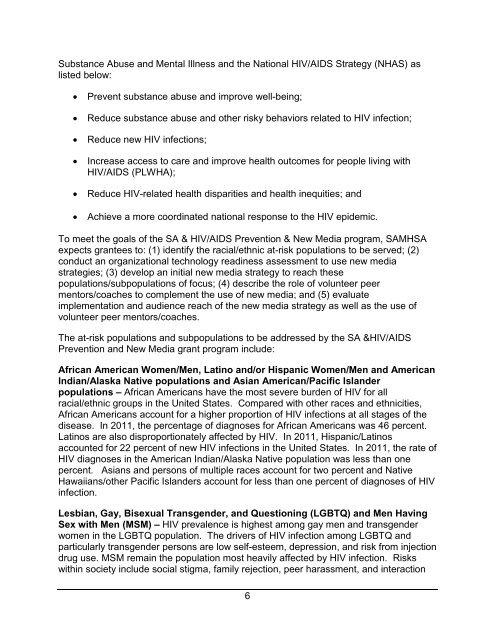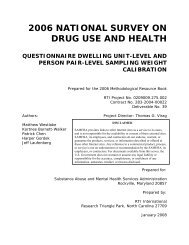Download Complete RFA Announcement (PDF | 324 KB)
Download Complete RFA Announcement (PDF | 324 KB)
Download Complete RFA Announcement (PDF | 324 KB)
You also want an ePaper? Increase the reach of your titles
YUMPU automatically turns print PDFs into web optimized ePapers that Google loves.
Substance Abuse and Mental Illness and the National HIV/AIDS Strategy (NHAS) as<br />
listed below:<br />
• Prevent substance abuse and improve well-being;<br />
• Reduce substance abuse and other risky behaviors related to HIV infection;<br />
• Reduce new HIV infections;<br />
• Increase access to care and improve health outcomes for people living with<br />
HIV/AIDS (PLWHA);<br />
• Reduce HIV-related health disparities and health inequities; and<br />
• Achieve a more coordinated national response to the HIV epidemic.<br />
To meet the goals of the SA & HIV/AIDS Prevention & New Media program, SAMHSA<br />
expects grantees to: (1) identify the racial/ethnic at-risk populations to be served; (2)<br />
conduct an organizational technology readiness assessment to use new media<br />
strategies; (3) develop an initial new media strategy to reach these<br />
populations/subpopulations of focus; (4) describe the role of volunteer peer<br />
mentors/coaches to complement the use of new media; and (5) evaluate<br />
implementation and audience reach of the new media strategy as well as the use of<br />
volunteer peer mentors/coaches.<br />
The at-risk populations and subpopulations to be addressed by the SA &HIV/AIDS<br />
Prevention and New Media grant program include:<br />
African American Women/Men, Latino and/or Hispanic Women/Men and American<br />
Indian/Alaska Native populations and Asian American/Pacific Islander<br />
populations – African Americans have the most severe burden of HIV for all<br />
racial/ethnic groups in the United States. Compared with other races and ethnicities,<br />
African Americans account for a higher proportion of HIV infections at all stages of the<br />
disease. In 2011, the percentage of diagnoses for African Americans was 46 percent.<br />
Latinos are also disproportionately affected by HIV. In 2011, Hispanic/Latinos<br />
accounted for 22 percent of new HIV infections in the United States. In 2011, the rate of<br />
HIV diagnoses in the American Indian/Alaska Native population was less than one<br />
percent. Asians and persons of multiple races account for two percent and Native<br />
Hawaiians/other Pacific Islanders account for less than one percent of diagnoses of HIV<br />
infection.<br />
Lesbian, Gay, Bisexual Transgender, and Questioning (LGBTQ) and Men Having<br />
Sex with Men (MSM) – HIV prevalence is highest among gay men and transgender<br />
women in the LGBTQ population. The drivers of HIV infection among LGBTQ and<br />
particularly transgender persons are low self-esteem, depression, and risk from injection<br />
drug use. MSM remain the population most heavily affected by HIV infection. Risks<br />
within society include social stigma, family rejection, peer harassment, and interaction<br />
6
















